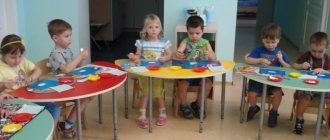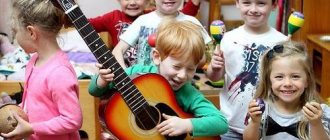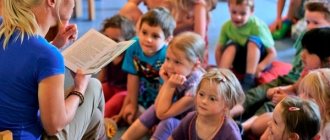Musical and rhythmic movements in kindergarten
Polina Levchikova
Musical and rhythmic movements in kindergarten
Guidelines
«Musical and rhythmic movements in kindergarten»
Music is the most emotional art (D. B. Kabalevsky)
.
Its impact on the formation of personality is enormous. “ It’s hard to imagine a person’s life music Without the sounds of music, it would not be complete, deaf, poor... Teachers and musicians have come to the conclusion that everyone has the inclinations for musical activity , i.e., the physiological abilities of the body, for example, the organ of hearing or the vocal apparatus. It is this that forms the basis for the development of musical abilities . And therefore it is considered proven that if the necessary conditions are created for musical development, then this has a significant effect in the formation of his musicality .
What is musicality ? This is a set of abilities that allow a person to actively express himself in various types of musical activities : listening, singing, movement .
Musical-rhythmic movements are a synthetic type of activity - this is one of the types in which the content of music , its character, and images are transmitted in movements . Therefore, any movements to music develop an ear for music , motor abilities, and the mental processes that underlie them and contribute to the emotional and psychophysical development of children.
Movements to music have been used in raising children since ancient times (Ancient India, China, Greece)
.
The synthesis of music and movements concretizes the game image. On the one hand, the musical image contributes to a more accurate and emotional execution of movements , on the other hand, the movements explain music , the main means of expression. Such complex phenomena as meter rhythm, register, musical form , which are difficult to explain to children in words, are perceived by preschoolers not only with the ear, but with the whole body, this increases the musical experience , making it more conscious.
Movement exercises are of invaluable importance, especially for somatically weakened children, children with an unstable nervous system, immaturity of the emotional-volitional sphere. After all, motor exercises primarily train the brain and the mobility of nervous processes . Therefore, it is so important to introduce clumsy, motor-inhibited children to movement to music , who need to be helped to gain feelings of self-confidence or, conversely, disinhibited and hyperactive children, in order to teach them to control their emotions and feelings. In the process of mastering movements to music children learn to focus on music as a special signal for action and movement , they improve motor skills, coordination of movements , develop voluntary movements , non-verbal communication abilities, and form and develop ideas about the connection between music and movements .
Introducing children to music comes in different ways. In the field of musical and rhythmic activity, it occurs through accessible and interesting proposals - exercises, musical games , dances, round dances, which help the child to better feel and love music , get into its mood, realize the nature of the work, understand the form, expressive means.
Musical and rhythmic activities are aimed at developing aesthetic, physical, moral and mental qualities in each child.
When learning musical and rhythmic tasks, the teacher uses various methodological techniques, taking into account the age characteristics of the children.
One of the most important teaching techniques is a holistic visual and auditory demonstration. Music and movements are one . Teacher alone (or with a child)
can show
a movement being learned to musical accompaniment . Correct demonstration of movements and precise instructions help the child perform a particular movement .
Musical-rhythmic movement , or in other words, dance, is a form of learning that is comfortable, interesting, and gives the opportunity for self-expression.
Mastering dance compositions, children memorize certain combinations of alternating movements , while striving to interact with each other, navigate in space, and improvise.
Experts call children of preschool age labor geniuses and great creators. The child creates not only drawings or plasticine figures, not only dance compositions and simple songs - the child creates himself, improves memory and attention, character and will.
The value of children's creativity is not in the result, but in the process; it is needed not by the audience, but by the children.
Ps: In kindergarten, instead of the term “rhythmic movements ,” “ musical-motor education ,” then “ movement to music ,” “ musical movement ,” “ musical-rhythmic movements ,” “ musical-rhythmic activity .” There has been debate over the years about the most precise formulation. However, there is no fundamental difference between all these terms, since most specialists in musical and rhythmic education in preschool institutions rightly considered music the “starting point” in rhythm, and movement as a means of its assimilation.
In the context of the modernization of physical education, the problem of developing new effective methods of physical education for preschool children and searching for such combinations of means, methods, and forms that would increase children’s interest in physical education, create a positive emotional background for them, intensify motor activity, and promote comprehensive development of motor qualities.
The traditional approach to the use of means and methods of physical education is not always sufficient to increase the functional capabilities of children's bodies and the effective development of basic motor qualities. The use of an unconventional technique - rhythmic gymnastics, helps to captivate the child and develop the need to engage in physical education. And subsequently, the habit of doing physical exercise on your own, thereby attracting children to a healthy lifestyle. Insufficient motor mode is one of the reasons for the weakening of the child’s body. Regular rhythmic gymnastics will help compensate for the lack of physical activity, as well as make up for additional physical activity in hyperactive children who need it.
Currently, rhythmic gymnastics is one of the most popular forms of physical education. The positive effect of rhythmic gymnastics on the body is confirmed by a number of domestic and foreign researchers. It promotes a rapid transition of the body from sleep to wakefulness, adjusts the central nervous system to the working rhythm, and prepares the body for upcoming vigorous activity. Rhythmic gymnastics is a set of physical exercises (walking, running, jumping, etc.) performed to music. Rhythmic gymnastics (also known as aerobics) is used for health purposes. The rhythmic gymnastics complex itself consists of a set of general developmental exercises for a variety of muscle groups. And almost every movement can be considered as a movement to develop coordination. And since the age of 4-7 years, in terms of the functional capabilities of children, the nature of the genetic development of motor function, is favorable for the development of many motor manifestations, including coordination ones, it is during this period that work on the formation of coordination movements must be carried out more intensively. In addition, senior preschool age plays a special role in the development of the child: during this period of life, new psychological mechanisms of activity and behavior begin to form. The age of 5-7 years is characterized by an intensification of the growth process: in a year a child can grow by 7–10 cm. Body proportions change. Movements are improved, children's motor experience expands, and motor abilities actively develop. Coordination and balance stability, which are so necessary when performing most movements, are noticeably improved. In children, large muscles of the trunk and limbs actively develop, but small muscles, especially the hands, still remain weak. Particular attention should be paid to the development of fine motor skills. An older preschooler performs most physical exercises technically correctly. Children show interest in their health. The child does not get tired so quickly and becomes more resilient. Thus, a complex of rhythmic gymnastics must be selected not only useful, but also entertaining, otherwise the desired result may not be achieved.
The set of rhythmic exercises is selected according to the principle from simple to complex, so children’s performance of coordination movements does not encounter any obstacles. Having learned a simple movement, various elements are added involving the arms, shoulders, and head. This is what contributes to the development of the ability to control the movements of your body. The structure of the exercises is unusual, so children like to do them with musical accompaniment. Under the influence of music, movements become clearer, rhythmic, and coordinated. Musical and rhythmic movements help the child learn to control his body, coordinate movements, coordinating them with the movements of other children, teach him to navigate in space, strengthens the basic types of movements, and promotes the development of dance and dance elements. The content of rhythmic gymnastics consists of general developmental exercises, so it is permissible to conduct it with preschool children. However, the age characteristics of children, motor mode, and rapid fatigue from performing the same exercises are observed.
All movements of rhythmic gymnastics can be conditionally classified as follows:
exercises for the arms and shoulder girdle. exercises for the muscles of the neck and torso. exercises for the legs and muscles of the whole body. Taking this into account, the content of rhythmic gymnastics classes for preschoolers includes exercises familiar to them: running, jumping, various types of walking; rhythmic movements combined with half-squats, side steps, expressive hand movements. Small wave-like movements of the body complement the exercises, turning them into a kind of sports dance. General developmental exercises in rhythmic gymnastics are performed from different starting positions: standing, sitting on the floor, lying on the stomach, back, side, in various supports.
Rhythmic gymnastics with children can be done in various ways:
In the form of physical exercises of a health-improving and training nature (a complex of rhythmic gymnastics is offered to children of senior preschool age, lasts 20-25 minutes). In the form of “rhythm blocks” used as part of physical education classes (lasting 10-30 minutes). When carrying out morning exercises, which enhances its healing and emotional effect. In children's demonstration performances at sports festivals (elements). Rhythmic gymnastics is carried out in the hall, in which wet cleaning and ventilation are first done. Classes are carried out with open windows or transoms, which provides ample access to fresh air. Children's clothing is lightweight, with cloth slippers or terry cloth, woolen socks, and leg warmers on their feet so that the child's feet do not get cold. The teacher is dressed in sportswear - this makes it more convenient to demonstrate exercises, especially from the starting positions sitting and lying down.
Each rhythmic gymnastics complex is used for 1 month. We learn exercises during morning exercises, in physical education classes, and individual elements in music classes, walks, and during outdoor games.
The structure of rhythmic gymnastics
Rhythmic gymnastics complexes include 3 parts.
Introductory - takes 7 - 10% of the class time, movements are performed at a moderate pace with a gradual increase in tempo. The introductory part consists of exercises that directly affect the child’s entire body. These are movements of a dynamic nature: walking, running, jumping. Rhythmic gymnastics complexes can begin with a wide variety of walking and running options. There are no more than four such options. Then follow general developmental exercises. Here the main goal of gymnastics is achieved - training large muscle groups, improving coordination of movements, and the ability to clearly and rhythmically perform exercises to music.
The main one takes 75-80% of the time, the exercises are carried out at a fast pace. At the beginning of the main part, a series of warm-up exercises follows: raising your arms up to the sides; exercises for the neck muscles: various head tilts, accompanied by a springy squat or walking in place without lifting the toes off the floor. Some exercises may have several variations in which the movements become gradually more complex. These exercises are performed from the same starting position. The next series of exercises is loading. Intensive exercises are used here: various bends, body swings, lunges, squats. For example, exercises “Bumblebee”, “Butterfly”, “Crane”, etc. this series of exercises takes place at a fast pace. When children perform exercises, special attention is paid to posture. This is followed by a ground floor series of exercises from starting positions sitting and lying down. This group of exercises is designed to develop spinal flexibility, strengthen the back muscles, abdominal muscles, and develop leg muscles. Here I use such exercises as “Tumbler”, “Breeze”, “Cradle”, “Frog”, “Basket”, etc. All exercises are performed at a moderate pace, as they require the most energy. The main part ends with a series of dance and running exercises. It takes place at an intense pace, with one exercise quickly followed by another. Various types of running and jumping are also used. Particular attention should be paid to the breathing of children.
Final – takes 10-15% of the time, includes relaxation exercises with deep breathing with a gradual decrease in the pace of their implementation in order to restore the body after stress and bring it to a state close to the original one. The exercises have their own name, this helps children correctly understand the nature of their implementation. The individual abilities of the children in the group and the conditions of the kindergarten should be taken into account. It is important to be gradual when increasing the load.
Rhythmic gymnastics helps develop coordination in preschool children.
Coordination is the ability to coordinate the movements of different parts of the body. The individual elements of movement are combined into a single motor action, which is performed economically, not tensely, plastically, clearly. Movements of the torso, head, arms and legs are made in three planes in relation to the body: facial, lateral, horizontal.
Movements of the arms and legs in relation to each other in space can be:
same name - movements coincide in direction (for example, the right arm and leg are moved to the right); opposite - performed in different directions (for example, during jumps, the right arm and left leg are raised and vice versa). Movements performed with arms or legs can be:
unidirectional (for example, both arms are raised up), multidirectional (for example, one arm is raised up, the other is moved to the side). simultaneous (for example, lying on your back, raising and lowering both legs); alternately (for example, standing, hands on the belt, first one leg is put on the toe, then the other); sequential - movements of the arms or legs follow one after another with a lag of half the amplitude (for example, standing, rotational movements of straight arms: while the right one is at the top, the left one is below, they seem to catch up with each other). It is easiest to coordinate movements if they are simultaneous and unidirectional; The greatest difficulty for preschoolers is caused by alternating movements. The most complex movements, accessible only to children of senior preschool age, are opposite and multidirectional movements.
Coordination of movements is impossible without spatial orientation; it is a necessary component of any motor action. In general developmental exercises, spatial orientation develops quickly, since visual and musculocutaneous sensations are simultaneously involved here, at the same time, the exercises are accompanied by explanations, instructions, and commands from the teacher.
The development of dexterity is directly related to the improvement of coordination abilities, spatial and temporal orientation, since dexterity is determined by the ability to quickly rearrange motor activity in accordance with a suddenly changing environment. These exercises place increased demands on attention, intelligence, and speed of reaction, since conditions can change quickly and unexpectedly.
Of the general developmental exercises, the greatest influence on the development of dexterity is exerted by general developmental exercises in which there is a quick change of posture (for example, from a sitting position with legs outstretched, lie on your stomach (back), roll around yourself in one direction, the other, sit down again); requiring coordinated actions of two or more children (for example, exercises in pairs, sitting opposite each other, exercises in subgroups with large gymnastic hoops, with long sticks, in a column - when passing the ball, etc.); with some objects (balls, jump rope, etc.). Agility exercises depend on the presence of motor experience, on the level of coordination in performing simple, isolated, as well as complex combinations of movements.
Coordination and dexterity of movements are impossible without the development of the balance function; for children, the more preferable combinations are symmetrical movements of the arms and unidirectional movements of the arms and legs. These coordination relationships are performed by children without special training and more accurately and coordinated. Teaching children to voluntarily perform coordinated actions increases the ability to regulate and balance their own actions, improves voluntary tension and relaxation of muscles, teaches the child to regulate and balance their movements, perform them with the greatest economy of force, and is a means of learning the capabilities of their motor system.
The correct selection of musical accompaniment not only improves the quality of movements, but also gives them special expressiveness, therefore the music accompanying rhythmic gymnastics should have a positive effect on the emotional state of children, the development of coordination of movements, hearing, and musical memory. The choice of music is determined by the nature of each exercise, as well as the level of aesthetic preparedness of the child. Music should have a positive effect on the emotional state of children.
The task of rhythmic gymnastics is not only to give a load and then bring it back to normal. It is important that children leave the hall in high spirits. This will be greatly facilitated by the music playing after the final part. She should be cheerful and cheerful. It is advisable to begin and end a rhythmic gymnastics lesson with the same, always cheerful and intense piece of music.
The coordinated actions of the physical education instructor and the teacher contribute to the effective implementation of rhythmic gymnastics in kindergarten. When introducing children to new general developmental exercises, the physical education instructor shows how to perform the exercise correctly, and the teacher monitors the correct execution of the exercises and helps the child with action - guides, supports.
Following the recommendations of the physical education instructor, the teacher organizes individual work with children who are lagging behind in mastering the program material, activates sedentary and weakened preschoolers, while taking into account the age characteristics of the children and their interests.
Thus, rhythmic gymnastics is an excellent means of versatile physical development and aesthetic education of a child, which originates far in the depths of history, which not only has a beneficial effect on all systems of the body (cardiovascular, respiratory, excretory, etc.), but also relieves mental stress, increases mental and physical performance, and improves well-being. And since the structure of rhythmic gymnastics is quite flexible, it is widely used in preschool institutions.
Kuznetsova M.N. System of comprehensive measures for improving the health of children in preschool educational institutions: A manual for health workers and educators. – M.: Arkti, 2002. Menkhin Yu.V., Menkhin A.V. Health-improving gymnastics: theory and methodology. Rostov n/d: Phoenix, 2002. Osokina T.I. Physical education in kindergarten: A manual for kindergarten teachers. – M.: Education, 1978. Penzulaeva L.I. Physical education classes with children 5-6 years old: A manual for kindergarten teachers. – M.: Education, 1988. Utrobina K.K. Entertaining physical education in kindergarten for children 5-7 years old: Notes on non-traditional activities and entertainment in the gym; notes on breathing exercises and acupressure; fun training, sports, didactic and outdoor games. – M.: GNOMiD, 2004.
MAGAZINE Preschooler.RF
The importance and necessity of musical and rhythmic movements in the life of a preschooler“Like a song, you compose your light dance” by A. Akhmatova.
The connection between music and space is especially clearly revealed in the art of dance. In the movements of the dancers, the sculpture seems to come to life. The language of choreography is the beauty and expressiveness of the human body. History is silent about the time when exactly dancing appeared. Since ancient times, dance has accompanied various labor processes and folk holidays; it is believed that rhythmic movements during religious rituals became the ancestors of dance.
Dance lessons, along with mathematics, philosophy, astronomy, natural science, logic, languages, etc., entered the education system back in Antiquity. Even then, the ability to dance well was a sign of good education and high position in society, because only wealthy people could afford to receive an education. It should be noted that pedagogical thought at all times and in many works of thinkers constantly turned to the fact that, along with mental development and education, physical development is also necessary. Psychologists add: physical activity contributes to the mental development of children. And dance, as one of the tools for physical development, will come in handy. The word “dance” is translated from the ancient Indian language as “body language” . And our body really has something to say...
Musical-rhythmic activity, which combines music, dramatization, pantomime, plastic arts and dance into a single complex, is one of the most effective types of aesthetic activity for the formation of artistic and creative abilities in children of senior preschool age. This type of activity is based on the motor-plastic elaboration of musical material, which corresponds to the visually active nature of the imagination of preschoolers. The strength and advantage of musical-rhythmic activity is that it arises and is based on familiar, exciting play activities in musical games, dramatizations of songs, plot dances, and in the process of this activity, the creative imagination of children develops especially clearly, and their creative manifestations are activated.
Movement for children is a natural process similar to the development of speech. The child’s endless need for movement is caused by the growth of the body. It is known that with the help of movement a child learns about the world and checks the readings of other analyzers. All this confirms the importance and necessity of such a section in preschool education as musical and rhythmic movements.
Nature has endowed children in early preschool age with a remarkable ability that facilitates the process of mastering both movements and speech - the ability to imitate. Imitating an adult, the child masters various types of movements and gradually begins to use them in independent activities, and then combines previously learned exercises and mastered new movements in his own way.
Musical-rhythmic movements are one of the most productive types of musical activity from the point of view of developing the musicality of preschool children and the formation of their creative personality traits. Rhythm is the transmission of the content of music, its character, images through movements; it is an emotional response to music. New life dictates a new rhythm in everything, and interest in all “bodily” techniques allows us to look at musical and rhythmic movements in preschool education from new positions. Musical-rhythmic movements provide an outlet for the child’s increased motor energy, contribute to the organization of a rational motor mode of the preschooler and the development of his musicality. They learn to control their body, and music brings its characteristic harmony to this process. After all, all musical and rhythmic movements fulfill a common task: to achieve the unity of the nature of movements and music.
Rhythmic exercises provide physical activity and promote the child’s physical development and strengthen the child’s body. In the process of musical-rhythmic education and performing movements to music, children develop a general outlook, artistic taste is formed, and their creative abilities develop. Thus, we can say that musical-rhythmic movements are an important means of forming a child’s bodily-motor experience, and, consequently, the development of his personality.
| Next > |






